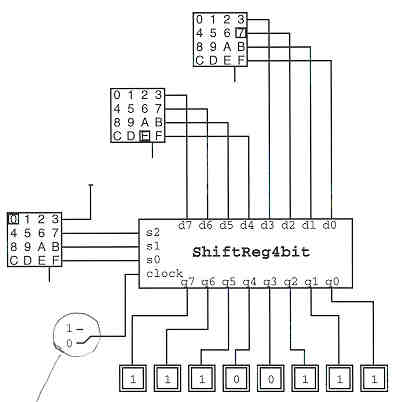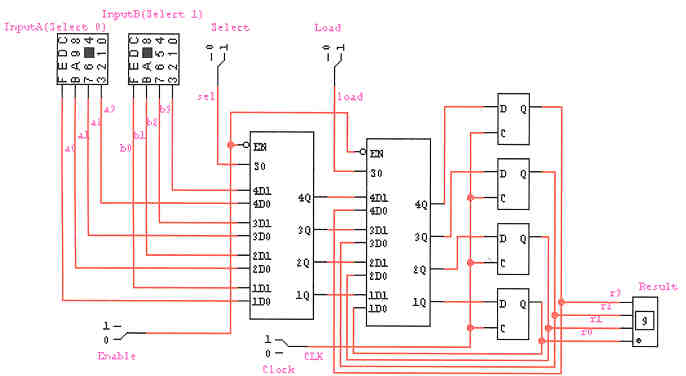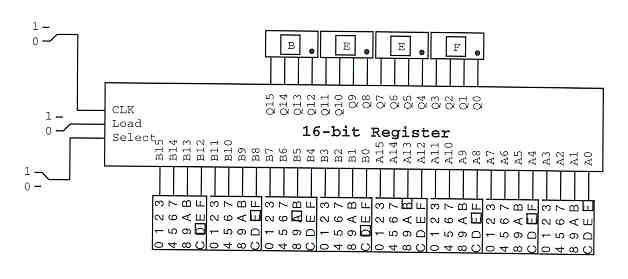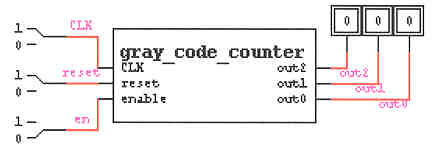
CSE 370 Solution Set #7
Spring 1999
Total Points 20
Problem 1 - 7 points

The Verilog below illustrates some important points.
You should use 2 always blocks: 1 on posedge CLK for changing states, and one on all the important inputs and internal registers for calculating the next state. This makes sense if you think about it from a hardware perspective. The registers are only looking at the data on the posedge CLK, but the next_state functions are combinational, which are always updating their values based on the value of the inputs. No points were deducted, for doing everything in one always block, but it doesn't make sense if you think about how it would be implemented.
It is important not to put any other inputs in the posedge CLK always block. If one of those inputs change then the registers will get a new value, and you no longer have a clock driven state machine.
The verilog below, as well as the rest of the verilog in the answer key, has not been run, so there may be little errors (missing ;. etc.).
Many of you made, or tried to make, your modules chainable. If you did this it requires external logic to do the rotates. If you put the rotation code internally the values will rotate inside each bit slice, instead of around the whole thing. To have a truly chainable component, it cannot know the difference between a shift and a rotate (since it doesn't know whether it's chained or not). You need to feed the appropriate bit in the LeftIn and RightIn inputs, based on the control values are set to. A simple AND gate that takes the Right Out as an input, and a line that goes high whenever Rotate Right is selected as another input will calculate the LeftIn bit. Of course you need a symmetric case for RotateLeft. This is unimportant for this assignment, but may be of interest to some of you.
module ShiftReg8bit(CLK, S2, S1, S0, d7, d6, d5, d4, d3, d2, d1, d0, q0, q1, q2, q3, q4, q5, q6, q7);
input CLK;
input S2,S1,S0;
input d7,d6,d5,d4,d3,d2,d1,d0;
output q0,q1,q2,q3,q4,q5,q6,q7;
reg qO, ql, q2, q3, q4, q5, q6, q7;
reg[7:0] indata;
reg[7:01 out;
reg[7:0] nextout;
reg[2:0] sel;
assign indata = {d7,d6,d5,d4,d3,d2,dl,d0};
assign sel = {s2,sl,s0);
// State Definitions
`define Hold 3'b000
`define Load 3'b001
`define Clear 3'b011
`define Complement 3'b011
`define ShiftRight 3'b100
`define RotateRight 3'b101
`define ShiftLeft 3'b110
`define RotateLeft 3'b111
/* clock driven "state" transitions */
always @(posedge CLK) begin
out = nextout;
$display(I,Input is %b, Sel is %d, Output is %b", indata, sel, out);
end
/* combinational logic to determine next output */
always @(out or sel or indata) begin
case(sel):
'Hold: nextout = out;
'Load: nextout = indata;
'Clear: nextout = 8'h00;
'Complement: nextout = ~out;
'ShiftRight: nextout = {1'b0, out[7:1]};
'RotateRight: nextout = {out[O], out[7:1]};
'ShiftLeft: nextout = {out[6:0], 1'b0};
'RotateLeft: nextout = {out[6:0], out[7]];
endcase
end
assign q7 = out[7];
assign q6 = out[6];
assign q5 = out[5];
assign q4 = out[4];
assign q3 = out[3];
assign q2 = out[2];
assign ql = out[l];
assign q0 = out[0];
endmodule
Sample Output (from $Display Statement)
Input= 11100111, sel= 0, out= 00000000 Input= 11100111, sel= 0, out= 00000000 Input= 11100111, sel= 0, out= 00000000 Input= 11100111, sel= 1, out= 11100111 Input= 11100111, sel= 1, out= 11100111 Input= 11100111, sel= 1, out= 11100111 Input= 11100111, sel= 2, out= 00000000 Input= 11100111, sel= 2, out= 00000000 Input= 11100111, sel= 2, out= 00000000 Input= 11100111, sel= 3, out= 11111111 Input= 11100111, sel= 3, out= 00000000 Input= 11100111, sel= 3, out= 11111111 Input= 11100111, sel= 4, out= 01111111 Input= 11100111, sel= 4, out= 00111111 Input= 11100111, sel= 4, out= 00011111 Input= 11100111, sel= 5, out= 10001111 Input= 11100111, sel= 5, out= 11000111 Input= 11100111, sel= 5, out= 11100011 Input= 11100111, sel= 6, out= 11000110 Input= 11100111, sel= 6, out= 10001100 Input= 11100111, sel= 6, out= 00011000 Input= 11100111, sel= 7, out= 00110000 Input= 11100111, sel= 7, out= 01100000 Input= 11100111, sel= 7, out= 11000000 Input= 11100111, sel= 6, out= 10000000 Input= 11100111, sel= 6, out= 00000000 Input= 11100111, sel= 5, out= 00000000 Input= 11100111, sel= 5, out= 00000000 Input= 11100111, sel= 4, out= 00000000 Input= 11100111, sel= 4, out= 00000000 Input= 11100111, sel= 3, out= 11111111 Input= 11100111, sel= 3, out= 00000000 Input= 11100111, sel= 2, out= 00000000 Input= 11100111, sel= 2, out= 00000000 Input= 11100111, sel= 1, out= 11100111 Input= 11100111, sel= 1, out= 11100111 Input= 11100111, sel= 0, out= 11100111 Input= 11100111, sel= 0, out= 11100111
Problem #2 - 3 points
It is not a good idea to play with the clock to stop flip-flops from latching. When you put logic in front of the clock, you delay the signal, and pretty soon all your registers are latching at different times. Clock skew can create some heinous bugs in your circuit. In this implementation you select which input to read with the leftmost mux (controlled by select) and choose whether to send in the values from the registers or the inputs with the second mux (controlled by load).

This is a sample waveform with a good explanation of what going on. All you need to do is tell me what is happening on each clock edge and why. This makes grading a lot easier.
g. 
Problem 3 - 3 points

Here is the verilog, but again it has not been actually compiled, so small syntax errors may exist. Notice again: Two Always Blocks!!! You also should have more comments then this : )
module Register(Select, Load, CLK, Q15, Q14, Q13, Q12, Qll, QIO, Q9, Q8, Q7, Q6, Q5, Q4,
Q3, Q2, Q1, Q0, AO, Al, A2, A3, A4, AS, A6, A7, A8, A9, AIO, All, A12, A13, A14,
A15, BO, BI, B2, B3, B4, B5, B6, B7, B8, B9, BIO, Bll, B12, B13, B14, B15);
input Select, Load, CLK;
output Q15, Q14, Q13, Q12, Qll, QIO, Q9, QB, Q7, Q6, Q5, Q4, Q3, Q2, Ql, QO;
input AO, Al, A2, A3, A4, AS, A6, A7, A8, A9, AIO, All, A12, A13, A14, A15;
input BO, BI, B2, B3, B4, B5, B6, B7, B8, B9, B10, Bll, B12, B13, B14, B15;
reg [15:0] state;
reg [15:0] next_state;
reg [15:0] inputa;
reg [15:0] inputb;
assign state = {Q15, Q14, Q13, Q12, Q11, Q10, Q9, Q8, Q7, Q6, Q5, Q4, Q3, Q2, Q1, Q0};
assign inputa = {AI5, A14, A13, A12, A11, A10, A9, A8, A7, A6, A5, A4, A3, A2, Al, AO};
assign inputb = {BI5, B14, B13, B12, B11, B10, B9, B8, B7, B6, B5, B4, B3, B2, B1, B0};
always @(posedge CLK) begin
state[15:0] = next_state[15:0];
$display("Clock: %h Load: %h Select: %h Input A: %h Input B: % h Output: %h",
CLK, Load, Select, inputa, inputb, state);
end
always @(Load or inputa or inputb or Select) begin
if (Load == 1'b1)
if (Select == 1'b1) next_state[15:0] = inputA[15:0];
else next_state[15:0] = inputB[15:0];
end
assign Q15 = state[I5];
assign Q14 = state[14];
assign Q13 = state[13];
assign Q12 = state[12];
assign Q11 = state[11];
assign Q10 = state[10];
assign Q9 = state[9];
assign Q8 = state[8];
assign Q7 = state[7];
assign Q6 = state[6];
assign Q5 = state[5];
assign Q4 = state[4];
assign Q3 = state[3];
assign Q2 = state[2];
assign Ql = state[l];
assign Q0 = state[0];
endmodule
And here is a sample test vector. You should add notes to your test vector just like the wave forms (unlike this one).
Clock: 1 Load: 0 Select: 0 Input A: dead Input B: beef Output: xxxx Clock: 1 Load: 0 Select: 0 Input A: dead Input B: beef Output: xxxx Clock: 1 Load: 0 Select: 1 Input A: dead Input B: beef Output: xxxx Clock: 1 Load: 0 Select: 1 Input A: dead Input B: beef Output: xxxx Clock: 1 Load: 1 Select: 1 Input A: dead Input B: beef Output: dead Clock: 1 Load: 1 Select: 1 Input A: dead Input B: beef Output: dead Clock: 1 Load: 1 Select: 0 Input A: dead Input B: beef Output: beef Clock: 1 Load: 1 Select: 0 Input A: dead Input B: beef Outpur: beef Clock: 1 Load: 0 Select: 0 Input A: dead Input B: beef Output: beef Clock: 1 Load: 0 Select: 0 Input A: dead Input B: beef Output: beef Clock: 1 Load: 0 Select: 0 Input A: beef Input B: dead Output: beef Clock: 1 Load: 0 Select: 0 Input A: beef Input B: dead Output: beef Clock: 1 Load: 1 Select: 0 Input A: beef Input B: dead Output: dead Clock: 1 Load: 1 Select: 0 Input A: beef Input B: dead Output: dead Clock: 1 Load: 1 Select: 1 Input A: beef Input B: dead Output: beef Clock: 1 Load: 1 Select: 1 Input A: beef Input B: dead Output: beef Clock: 1 Load: 0 Select: 1 Input A: beef Input B: dead Output: beef Clock: 1 Load: 0 Select: 1 Input A: beef Input B. dead Output: beef
Problem 4 - 7 points

Gray Code Counter. Again, verilog was copied and may have
small syntactic errors, but the overall form is correct. Putting the reset in you
posedge CLK always block saves some keystrokes in the other always block. Note
that nowhere do I use any sequential assignment (i.e. assigning next_state, then
re-assigning it later in the same block of code). How would this be accomplished in
hardware? It wouldn't!!! hardware is inherently parallel. You should only
assign to a given variable one per execution of an always block.
module gray_code-counter(enable, reset, CLK, out0, outl, out2);
input enable, reset, CLK; output out0, outl, out2;
/* internal registers */
reg [2:0] state;
reg [2:0] next_state;
/* clock driven state registers - easy place for reset */
always @(posedge CLK) begin
if(reset) state = 3'b110;
else state = next_state;
$display("out= %h, state= %h, reset= %b, enable= %b", out, state, reset, enable);
end
/* combinational logic */
always @(enable or state) begin
if(enable) begin
case (state)
3'b000: next_state = 3'b001;
3'b001: next_state = 3'b011;
3'b011: next_state = 3'b010;
3'b010: next_state = 3'b110;
3'b110: next_state = 3'b111;
3'b111: next_state = 3'b101;
3'b101: next_state = 3'b100;
3'b100: next_state = 3'b000;
endcase
end
else next_state = state;
end
/* output assignments */
assign out2 = state[2];
assign out1 = state[1];
assign out0 = state[0];
endmodule
Test Output - Note the $display is in the posedge CLK always, giving one output per cycle. This is good.
out= 000 state= 000 reset= 0 enable= 0 out= 000 state= 110 reset= 1 enable= 0 out= 110 state= 110 reset= 1 enable= 0 out= 110 state= 110 reset= 0 enable= 0 out= 110 state= 110 reset= 0 enable= 0 out= 110 state= 111 reset= 0 enable= 1 out= 111 state= 101 reset= 0 enable= 1 out= 101 state= 100 reset= 0 enable= 1 out= 100 state= 000 reset= 0 enable= 1 out= 000 state= 001 reset= 0 enable= 1 out= 001 state= 011 reset= 0 enable= 1 out= 0ll state= 010 reset= 0 enable= 1 out= 010 state= 110 reset= 0 enable= 1 out= 110 state= 111 reset= 0 enable= 1 out= 111 state= 101 reset= 0 enable= 1 out= 101 state= 110 reset= 1 enable= 1 out= 110 state= 110 reset= 1 enable= 1 out= 110 state= 111 reset= 0 enable= 1 out= 111 state= 101 reset= 0 enable= 1